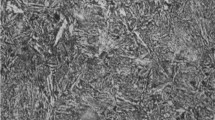Abstract
AISI 1024 steel was severely deformed by using warm (500 °C) multiaxial forging (MAF) technique using up to nine forging passes in order obtain a composite ultrafine grained (UFG) microstructure consisting of fragmented cementite particles. Microstructural evolution is studied using optical and electron microscopy. After warm MAF, the hardness and strength properties improved significantly, although total elongation values decreased. The tribological properties of UFG low carbon steel produced by MAF have been investigated. Dry sliding was carried out using constant sliding speed. The wear test results showed that the strengthening of AISI 1024 steel by warm MAF processing did not lead to improvement of wear resistance. The results are explained on the basis of its microstructural features and lower pull-off work. Higher grain boundary density, presence of submicron-sized cementite particles, and lower pull-off work are found to be responsible for lower sliding wear resistance of UFG steel.












Similar content being viewed by others
References
Belyakov A, Sakai T, Miura H, Kaibyshev R (2000) Scripta Mater 42:319
Valiev RZ (1997) Mater Sci Eng A 234–236:59
La PQ, Ma JQ, Zhu YT, Yang J, Liu W, Xue Q, Valiev R (2005) Acta Mater 53:5167
Kim YS, Lee T, Park KT, Kim WJ, Shin DH (2002) TMS (UFG materials II, proceeding of a symposium, TMS annual meeting)
Kim YS, Ha JS, Shin DH (2005) Mater Sci Forum 475–479:401
Gao LL, Cheng X (2008) Wear 265(7–8):986
Garbacz H, Gradzka-Dahlke M, Kurzydłowski K (2007) Wear 263:572
Purcek G, Saray O, Kul O, Karaman I, Yapici G, Haouaoui M, Maier H (2009) Mater Sci Eng A 517:97
Stolyarov VV, Shuster LS, Migranov MS, Valiev RZ, Zhu YT (2004) Mater Sci Eng A 371:313
Padap AK, Chaudhari GP, Nath SK, Pancholi V (2009) Mater Sci Eng A 527:110
Lim SM, Wahabi ME, Desrayaud C, Montheillet F (2007) Adv Mater Res 5–17:900
Salishchev GA, Valiakhmetov OR, Galeyev RM (1993) J Mater Sci 28:2898. doi:10.1007/BF00354692
Hyde TH, Sun W, Williams JA (2007) Int Mater Rev 52:213
Song R, Ponge D, Raabe D, Kaspar R (2005) Acta Mater 53:845
Hutchings IM (1992) Tribology: friction and wear of engineering materials. Edward Arnold, London, pp 26–83
Bhushan B (2002) Introduction to tribology. Wiley, New York, p 345
Wayne S, Rice S, Minakawa K, Nowotny H (1983) Wear 85:93
Arnell RD, Davies PB, Halling J, Whomes TL (1991) Tribology principles and design application. Springer, New York, p 46
Acknowledgements
All India Council for Technical Education supported one of the authors at IIT Roorkee under its QIP scheme. Authors gratefully acknowledge the funding provided through the faculty initiation grant of Indian Institute of Technology Roorkee.
Author information
Authors and Affiliations
Corresponding author
Rights and permissions
About this article
Cite this article
Padap, A.K., Chaudhari, G.P. & Nath, S.K. Mechanical and dry sliding wear behavior of ultrafine-grained AISI 1024 steel processed using multiaxial forging. J Mater Sci 45, 4837–4845 (2010). https://doi.org/10.1007/s10853-010-4430-7
Received:
Accepted:
Published:
Issue Date:
DOI: https://doi.org/10.1007/s10853-010-4430-7




